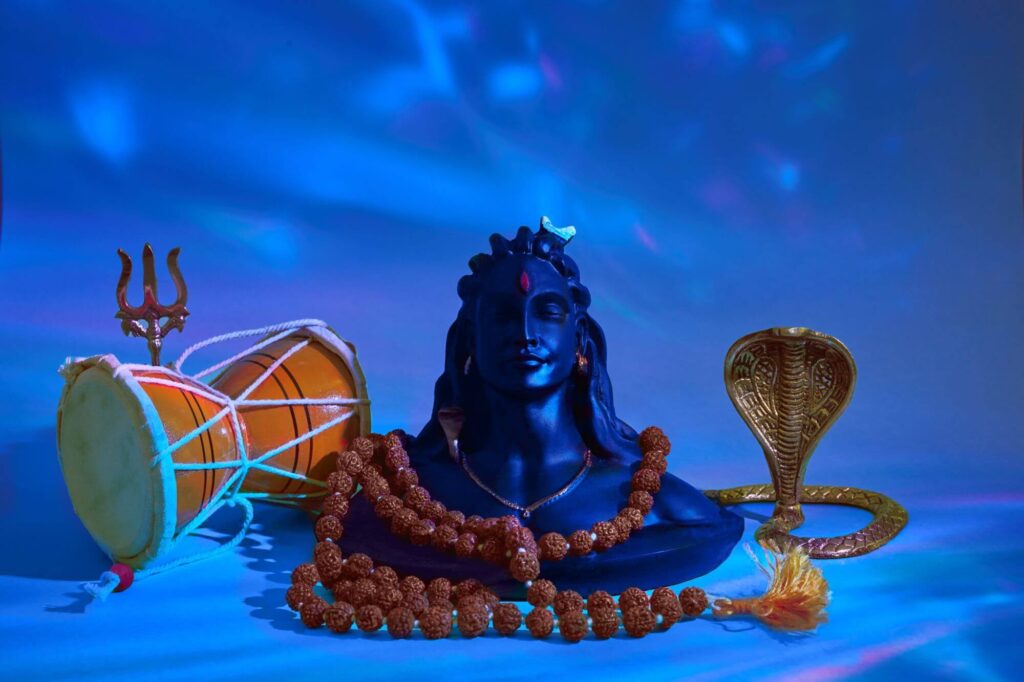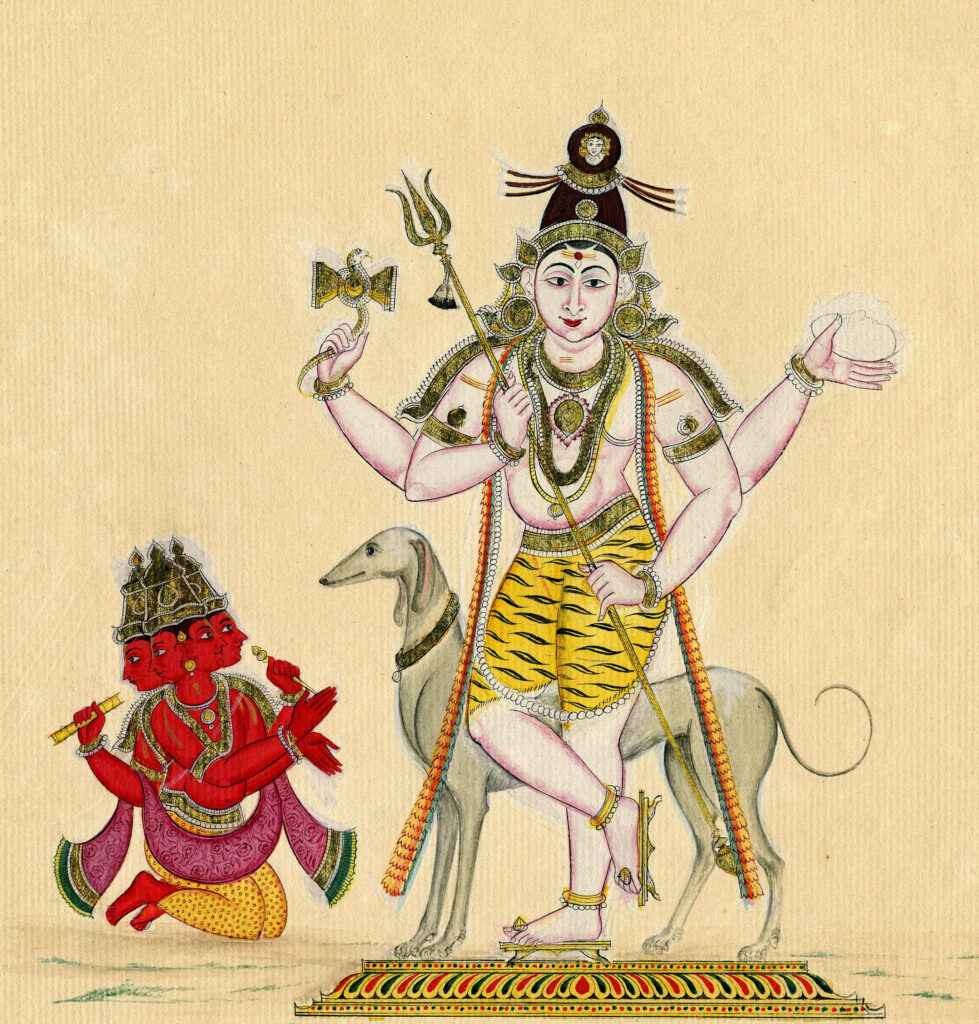“When Shiva beats his Damaru, evil shakes while the wise awake,” begins the timeless adage, encapsulating the profound significance of Lord Shiva’s sacred instrument.
Lord Shiva is one of the most important gods in Hinduism. Shiva is a member of the trimūrti, the supreme divine triad, along with Brahma and Vishnu. He is associated with time and is the creator and destroyer of all things.
The rhythmic beats of Lord Shiva’s Damaru — a small drum-shaped instrument held by Lord Shiva — resonate deeply within the collective consciousness of Hinduism, above all in the annual festival of Maha Shivratri, which falls in late February or early March. The drum is a symbol of rhythm, time and cosmic sound. The rhythmic beats produced by its two ends symbolize the dualities inherent in existence: life and death, light and darkness, creation and destruction. At first glance, the Damaru’s shape resembles an hourglass, representing the eternal flow of time — a concept central to Hindu philosophy.

The Damaru with other symbols of Lord Shiva.
In Lord Shiva’s cosmic dance, known as the Tandava, the Damaru’s sound sets the rhythm for the universe’s perpetual motion, signifying the cycle of birth, death, and rebirth. With its simple yet profound design, this sacred instrument held a spiritual and historical connection that transcended time and space. It serves as a poignant reminder of the eternal cycle of life and death. Shiva, often depicted holding the Damaru, is particularly iconic in the Nataraja form, where the rhythmic beats of the Damaru accompany his cosmic dance of creation and destruction. Sometimes depicted in other dancing postures, Shiva’s presence with the Damaru remains a powerful symbol. The Damaru is tied to his Trishul or trident in certain depictions, further emphasizing its significance. The sound emanating from the Damaru symbolizes the primal sound of creation, perpetuating the universe’s eternal rhythm.
In Hinduism, particularly among Shiva devotees, it is firmly believed that Shiva’s beating of the Damaru heralded the first sound, known as “nada.” This inaugural sound emerged from the depths of the void, resonating with the essence of creation. As Shiva commenced his divine dance, guided by the rhythm of the Damaru, the cosmos sprang forth into existence. Moreover, the shape of the Damaru holds symbolic significance—the upper portion represents the male creative force (the Lingam), while the lower portion embodies the female creative energy (the Yoni). Symbolically, the convergence of the Lingam and Yoni at the midpoint of the Damaru signifies the genesis of creation, while their separation signifies destruction’s inevitable course. The beats of Shiva’s Damaru reverberated throughout the universe, setting the rhythm for the eternal cycle of existence. With each tap of the drum, the divine sound echoed the pulsating energy of creation, symbolizing the cosmic vibrations that underpinned all of reality.

Painting of Siva as Bhairava. Andhra Pradesh or Tamil Nadu, circa 1820. Via the British Museum.
Symbolism of the Damaru in Hindu iconography
Ancient Indian artists and sculptors have depicted the Damaru for thousands of years in their works. Its presence in Hindu iconography underscores its enduring significance as a spiritual awakening and enlightenment symbol. From Varanasi’s temples to Ellora’s caves, the image of Lord Shiva wielding the Damaru is a timeless reminder of the divine power that permeates the cosmos.
Moreover, the ancient yogic traditions of India revered sound as a powerful tool for spiritual transformation; hence, Lord Shiva’s association with Damaru evokes its significance. Through Nada Yoga, practitioners harness the vibrational energy of sound to unlock higher states of consciousness and commune with the divine. The rhythmic beats of the Damaru, when played with intention and devotion, have the power to transport the listener to realms beyond the material world, where the soul finds refuge in the eternal embrace of the divine.

Painting of Siva presenting the cakra to Vishnu. Andhra Pradesh or Tamil Nadu, circa 1820. Via the British Museum.
The Indira Gandhi National Centre for the Arts (IGNCA) recently showcased a special exhibition on the various types of Damaru, exhibiting the rich tapestry of India’s cultural and religious diversity. Beyond its symbolism, the Damaru manifests in multiple shapes, sizes, and materials, each imbued with its unique significance. This exploration not only sheds light on the diverse cultural heritage of India but also unveils the deep connections between the Damaru and various Shiva sects and devotees, including Aghoris, Nagas, and others.
In the holy city of Varanasi, the traditional wooden Damaru reigns supreme, its intricate carvings and embellishments reflecting the city’s rich artistic heritage. For Aghoris, the Damaru symbolizes Shiva’s cosmic dance and worldly attachments’ transcendence.
Similarly, among the Nagas, Damaru is sacred in their rituals and ceremonies. The Naga Damaru embodies the warrior spirit and the indomitable will to overcome adversity. In the southern state of Tamil Nadu, the brass Damaru takes center stage, reflecting the region’s vibrant cultural traditions and artistic craftsmanship. Here, devotees from the Shaiva Siddhanta tradition revere the Damaru as a symbol of divine grace and spiritual awakening.
Cultural and spiritual significance of Damaru across India
In the mountainous regions of the Himalayas, the Damaru finds its most primal expression. The Himalayan Damaru embodies the raw power and elemental energy of the mountains.
The diverse types of Damaru found across India showcase the country’s rich cultural heritage and highlight the deep spiritual connections between the instrument and various Shiva sects and devotees.
Moreover, the Damaru’s shape is reminiscent of the lingam, a symbol of divine energy and fertility associated with Lord Shiva. Just as the lingam represents the union of male and female energies, the Damaru embodies the balance between opposing forces—Shiva and Shakti, Purusha and Prakriti. Through Damaru’s rhythmic sounds, Lord Shiva harmonizes these dualities, fostering the unity of opposites within the individual and the cosmos.
In Hindu mythology, the Damaru is often depicted alongside Nandi, Lord Shiva’s bull vehicle, further emphasizing its sacred significance. Nandi, a symbol of strength and stability, listens intently to Damaru’s beats, symbolizing the receptive aspect of creation. Together, the Damaru and Nandi embody the complementary forces of creation and receptivity, illustrating the interconnectedness of all beings in the cosmic dance of life.
Beyond its mythological and symbolic connotations, the Damaru holds practical significance in Hindu rituals and ceremonies. Devotees use it to accompany devotional songs and chants, invoking the presence of Lord Shiva and facilitating spiritual communion. The symbolism of the Damaru transcends its physical form. As Lord Shiva’s sacred instrument, it serves as a reminder of the eternal dance of creation, preservation, and destruction that animates the universe. Through its rhythmic beats, the Damaru symbolizes the cosmic vibrations underpinning all creation, offering devotees a pathway to spiritual enlightenment and divine communion.
[Liam Roman edited this article]
The views expressed in this article are the author’s own and do not necessarily reflect Fair Observer’s editorial policy.
Support Fair Observer
We rely on your support for our independence, diversity and quality.
For more than 10 years, Fair Observer has been free, fair and independent. No billionaire owns us, no advertisers control us. We are a reader-supported nonprofit. Unlike many other publications, we keep our content free for readers regardless of where they live or whether they can afford to pay. We have no paywalls and no ads.
In the post-truth era of fake news, echo chambers and filter bubbles, we publish a plurality of perspectives from around the world. Anyone can publish with us, but everyone goes through a rigorous editorial process. So, you get fact-checked, well-reasoned content instead of noise.
We publish 2,500+ voices from 90+ countries. We also conduct education and training programs
on subjects ranging from digital media and journalism to writing and critical thinking. This
doesn’t come cheap. Servers, editors, trainers and web developers cost
money.
Please consider supporting us on a regular basis as a recurring donor or a
sustaining member.
Will you support FO’s journalism?
We rely on your support for our independence, diversity and quality.








Comment